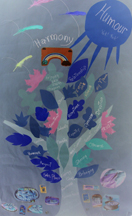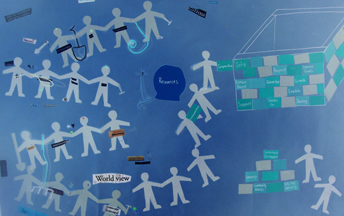The Learning Circles Project |
||
| Summary - Indigenous by Janice Brant |
||
This overview draws upon diverse examples of learning circles identified in Indigenous communities across Canada. In both rural (on reserve) and urban (off reserve) centres Indigenous people gather in circles seeking self-knowledge, individual and community survival, well-being, and wholeness. Indigenous community organizations such as friendship centres, health centres, libraries, literacy programs, healing lodges, and band administration offices were instrumental in the identification of learning circles that exist in various forms. In this study, we identified a broad range of learning circles in the Indigenous community that support and engage its members in purposeful and experiential learning. This overview includes and reflects upon the diversity of learning circles identified in the study, along with learning circles that were observed more closely. The revitalization of circles throughout the Indigenous community beginning in the 1960s offered Indigenous people a return to the multidimensional, holistic, and relational reality of Indigenous approaches to teaching and learning. Indigenous philosophies of teaching and learning are characterized and formed by experience, observation, communal relationships, ceremony and sacred ecology, artistic and mythical elements, psychological, and spiritual connections. These characteristics are integral and consistent in the diversity of learning circles identified in the Indigenous community. Learning circles in the Indigenous community support cultural and linguistic revitalization, build community, strengthen identities, celebrate diversity, and respond to political, social, economic, health, and spiritual aspirations of Indigenous people. Common to all of the learning circles identified in this project is an underlying desire for reclaiming and healing the trauma of colonization that has eroded Indigenous cultures and languages, separated families, and seriously disrupted the identity of Indigenous people and their sense of place in the world. Circles provide Indigenous people with a safe and supportive environment in which to give voice to lateral violence, unresolved grief, fear, anger, and shame that have created and sustained unhealthy behaviors in Indigenous families and communities. The circle itself creates a sacred space that orchestrates healing by working to restore balance and harmony, well-being, joy and love, humour, and enlightenment. The very nature of circles is conducive to healing (teaching and learning) and can significantly form and strengthen the identities of Indigenous people individually and collectively. The development of voice plays a crucial role in the learning circles identified in the Indigenous community. Many of the learning circles that were interviewed via telephone, email, or personal visits favour oral tradition and view speaking and/or listening as active participation. With the exception of the Family History Circle, almost no print or written materials were used in the identified circles. All of the circles build on oral fluency and encourage participants to listen, observe, remember, and share. Some circles use drumming and singing to help Indigenous people find their voice and reconnect with cultural teachings, stories, and philosophies that offer new insight and ways of being in the world. Other circles foster a healing relationship with the land and sacred ecology, through ceremonies, sweat lodges, fasting, and harvesting traditional foods to eat and nourish their bodies. Learning circles that build upon and strengthen oral tradition, foster individual and community well-being, and encourage spiritual wholeness also support each individual in telling their own stories. Storytelling in its many forms is evident in learning circles and valued in Indigenous communities. Communities of people have always listened to and shared stories to warn of danger, gain new insight, solve problems, celebrate change, and make spiritual connections. These stories come from our relations and ancestors to support continual and life long learning. Elders and traditional teachers use storytelling to remind us that we were made with two ears and one mouth. And that because of our design it is our nature to listen twice as much as we talk. The gift of two ears and one mouth is the ability to hear things from more than one side and to speak one truth. These skills are especially desirable in the Indigenous community and when listening to stories. Stories offer insight about people, places, and the world. In learning circles every participant is seen as a teacher and a learner, although every circle has a lead participant that facilitates and supports the circles process. In some of the learning circles the lead participant may change or vary from meeting to meeting depending on the topic or event. The lead participant is essentially determined by what gifts, knowledge or skills support the circle needs or aspirations at that time. This concept of leadership is generally accepted as the natural flow of things or is decided upon collectively. The sharing of personal stories and individual experiences are common and welcomed within the circle. Each participant is respected for the unique perspective and gifts they bring to the circle and are considered valuable to the whole. In the Sewing Circle for example, each participant has opportunities to share their skills and abilities related to sewing, and, by being receptive to the sharing of others, has learned collectively through participation. Learning circles in the Indigenous community maintain a primarily informal and flexible approach to teaching and learning that honours the circle as sacred, reflects the natural reciprocity of relationships, and respects the autonomy of individuals. The circles tend to be inclusive and responsive to the spiritual, emotional, intellectual and physical needs and aspirations of participants, who guide and shape the direction of their learning circle. Learning circles in the Indigenous community often include or are centered on experiential learning opportunities. Each learning circle offers participants the opportunity to build, create, or make something whether it is a craft, drum, family tree, or food to share with the circle. Experiential and peer learning opportunities are significant to learning circles identified in the Indigenous community. Indigenous community organizations such as friendship centres, health centres, libraries, literacy programs, healing lodges, and band administration offices play a crucial role in building community through their support of learning circles. Many of the learning circles identified in this projected are founded in partnership with community members and community organizations. The Family History Circle and Hand Drum Circle, for example, may not have been possible without the support of Kanhiote Library and the Barrie Native Friendship Centre. These organizations and others have offered their support by providing a space for circles to meet, encouraging staff to volunteer as facilitators, making donations, including them in their newsletters, or supporting fundraising initiatives. Enaahtig Healing Lodge and Learning Centre supported the Sewing Circle by inviting them to make gifts to be given away at lodge events and ceremonies. In return a donation was given to the circle to support their need for materials. Without the support of organizations in the Indigenous community it would be difficult for learning circles to meet and carry out many of their activities, including fundraising for special workshops and guest facilitators. In summary, the learning circles identified in the Indigenous community worked towards and promoted cultural literacy, healing, and self-knowledge in an environment rich in kindness, caring, and respect. There were no prerequisites for participating in these circles, only a desire to learn, share, build relationships, strengthen community, and celebrate the unique identity and experiences of Indigenous peoples. |
||

